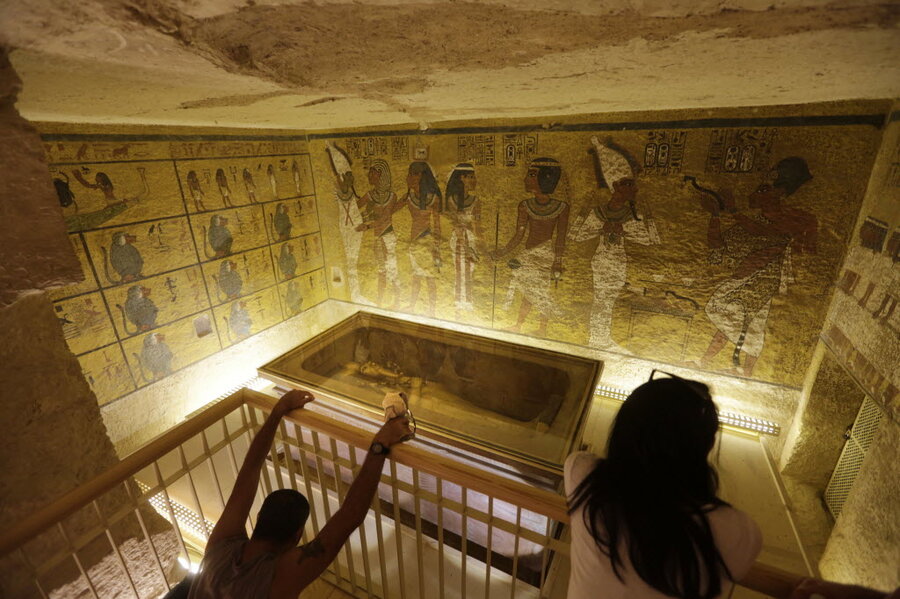Have Egyptologists solved the mystery of Queen Nefertari's knees?
Loading...
In 1904, Italian archaeologist Ernesto Schiaparelli excavated the long-lost ancient Egyptian crypt where Queen Nefertari, one of Egypt’s most famous queens and wife of the great Pharaoh Ramses II, was preserved for the afterlife.
In the tomb, Mr. Schiaparelli found a pair of knees, which archeologists have long assumed that had belonged to the esteemed queen. But more than 100 years after the discovery, a team of international archaeologists and chemists using radiocarbon dating and genetic studies have confirmed Schiaparelli's hypothesis.
“The most likely scenario is that the mummified knees truly belong to Queen Nefertari,” the researchers wrote. “Although this identification is highly likely, no absolute certainty exists.”
Some archaeologists have criticized their findings, saying that despite all their tests, the researchers have only confirmed a long-standing theory, not added anything new to the historical understanding of the time period.
Nefertari's 3,200-year-old tomb, once described as the Sistine Chapel of the ancient Egyptian world, has not fared well. Within just a few hundred years of her burial it was plundered. Thieves stripped large sections of the murals that commemorated the queen’s beauty, broke her rose granite sarcophagus, and, in their search for jewels and gold, and likely broke her legs.
With only small fragments of femur and tibia leg bones available, it was difficult for archaeologists to come to any conclusions about the legs.
"We know certainly in the Valley of the Queens, from previous work we've done, that individuals were often buried in earlier tombs," Joann Fletcher, co-author of the study and an Egyptologist from the University of York, told NPR. "We had no way of knowing if these were Nefertari's remains or not. They could have been washed into the tomb at a later date during one of these occasional flash floods that do occur in that part of Egypt."
But the research team ruled out the possibility that it was an older corpse left in the tomb, or a newer one washed in, using radiocarbon dating. Then, using other genetic, paleopathology, and chemical tests, they were able to further identify the knees.
An X-ray examination of the legs showed that they came from the same body. Further tests confirmed that they belonged to a woman who was approximately 40 years old at time of death, as Nefertari was when she disappeared from public life.
Using comparisons with other ancient, more complete skeletons, the researchers concluded that the legs belonged to someone 5 feet 4 inches tall. While this was an above-average height for the time, the murals in Nefertari’s tomb depict a statuesque woman. Additionally, a pair of ornate women’s sandals found in the tomb were designed for a tall person.
The tests found that the legs were mummified using animal fat, the typical mummification practice for the upper-class during Ramses II’s reign, reported the Washington Post.
"They'd been mummified to a very high standard using the most costly of ingredients. Very careful wrapping, a lot of attention to detail," Professor Fletcher told NPR.
The mummification materials, along with signs of an easier and less labor intensive lifestyle, point to an individual in the highest strata of ancient Egyptian society, the researchers concluded.
Fletcher has argued that Nefertari played a more significant role than most women did at the time, though most surviving reports highlight only her beauty.
Her primary role was "the decorative bystander when Ramses was flexing his pharaonic muscles at public events," she told the Guardian.
"She was there as the eye candy,” Fletcher acknowledged, "but really, [she was] a striking woman who I think exerted a quiet power behind the throne.”
Nefertari was known to exchange letters and gifts with contemporaries from around the world, playing an important diplomatic role. While Ramses II had many wives and fathered more than 100 children, archaeologists believe that Nefertari was his favorite – citing her lavish tomb as well as a temple he built in her honor.
"The irony is, of course, that we can never compare [her rumored beauty] to the physical reality because the knees are it,” Fletcher told NPR. “There's no face, there's no extra parts. It's just literally a mummified pair of knees and some of the legs.”








